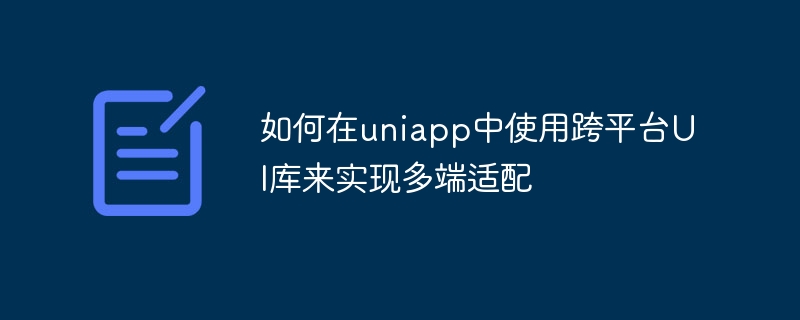

How to use cross-platform UI library in uniapp to achieve multi-terminal adaptation
With the development of mobile Internet, multi-terminal adaptation has become an important issue in mobile application development . To address the differences between different platforms, an effective solution is to use cross-platform development frameworks and UI libraries. uniapp is a popular cross-platform development framework that can develop small programs, apps and H5 pages at the same time, while cross-platform UI libraries such as vant or weui can provide consistent interface styles and reusable components. This article will introduce how to use the cross-platform UI library in uniapp to implement multi-terminal adaptation, and give specific code examples.
1. Introducing the UI library
First, we need to introduce the cross-platform UI library into the uniapp project. Taking vant as an example, we can install vant through npm and introduce the required components into the project.
npm install vant
{
"usingComponents": {
"van-Button": "/npm/vant/es/button/index"
}
}import { Button } from 'vant';
export default {
components: {
[Button.name]: Button
},
// ...
}2. Use UI components
After introducing the UI library, we can use UI components in uniapp to achieve multi-terminal adaptation. Taking vant's Button component as an example, suppose we need to display a button in the mini program, App and H5 page. This can be achieved through the following steps.
<template>
<view>
<van-Button type="primary" @click="handleButtonClick">{{ buttonText }}</van-Button>
</view>
</template>export default {
data() {
return {
buttonText: '点击按钮'
}
},
methods: {
handleButtonClick() {
// 处理按钮点击事件
console.log('按钮被点击了!');
}
}
} 3. Style Adaptation
In addition to component adaptation, style adaptation is also an important part of realizing multi-terminal adaptation. Since different platforms have different parsing rules for styles, we can use uni's style variables and conditional compilation to implement style adaptation.
<template> <!-- ... --> </template> <style> /* 是否为 iPhoneX 等异形屏 */ @import "./styles/iphoneX.scss"; /* 全局样式变量 */ @import "./styles/variables.scss"; /* 其他样式 */ @import "./styles/common.scss"; </style>
/* styles/variables.scss */ /* 字体大小 */ $font-size-base: 30upx; $font-size-title: $font-size-base + 4upx; /* 颜色 */ $color-primary: #07c160; $color-secondary: #fc5c65;
<template>
<view :class="$statusBarHeight ? 'iphone-x' : ''">
<!-- ... -->
</view>
</template>/* styles/iphoneX.scss */
@support (padding-top: constant(safe-area-inset-top)) {
/* iPhoneX 等异形屏幕顶部安全区域高度 */
.iphone-x {
padding-top: env(safe-area-inset-top);
}
}By introducing UI libraries and using style adaptation, we can easily implement multi-terminal adaptation in uniapp. This not only improves development efficiency, but also ensures consistent interface style and user experience on different platforms. I hope this article can help you rationally use cross-platform UI libraries to achieve multi-terminal adaptation in the uniapp project.
The above is the detailed content of How to use cross-platform UI library in uniapp to achieve multi-terminal adaptation. For more information, please follow other related articles on the PHP Chinese website!




